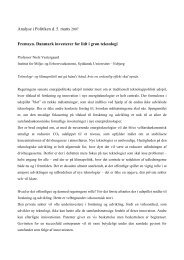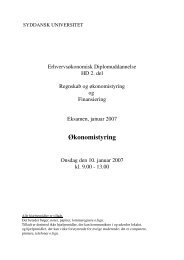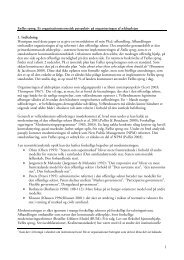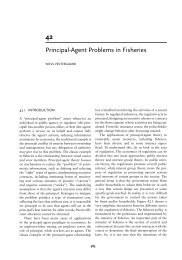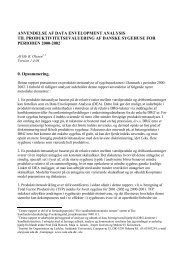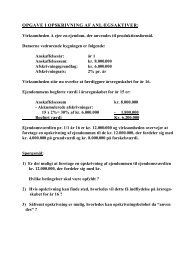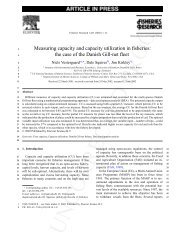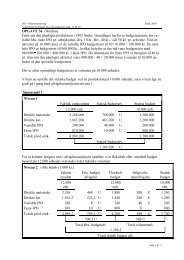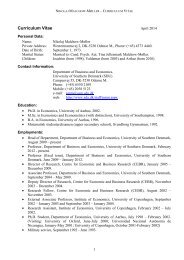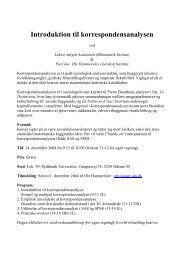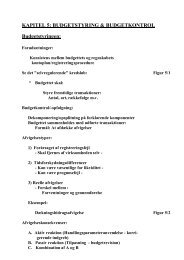Development of Parties and Party Systems in ... - lah@sam.sdu.dk
Development of Parties and Party Systems in ... - lah@sam.sdu.dk
Development of Parties and Party Systems in ... - lah@sam.sdu.dk
- No tags were found...
You also want an ePaper? Increase the reach of your titles
YUMPU automatically turns print PDFs into web optimized ePapers that Google loves.
which attitudes to state regulation <strong>and</strong> the welfare state are the most decisive s<strong>in</strong>gle factorsseparat<strong>in</strong>g the parties <strong>in</strong>volved <strong>in</strong> elections.In the case <strong>of</strong> Pol<strong>and</strong> the left-right axis has been closely l<strong>in</strong>ked to the socio-cultural dimension, <strong>in</strong>particular questions about the proper role <strong>of</strong> the church <strong>in</strong> society <strong>and</strong> attitudes to the communistpast. <strong>Parties</strong> with a strong anti-communist <strong>and</strong> market- <strong>and</strong> euro-sceptical characteristics has beendescribed as right-traditionalistic. On social issues <strong>and</strong> state regulation the Polish right w<strong>in</strong>g partieshave behaved more ”social democratic” than the post-communist parties, <strong>in</strong>clud<strong>in</strong>g the democraticleft alliance SLD <strong>and</strong> the Peasants <strong>Party</strong> (PSL). Symbolic politics <strong>and</strong> low programme crystalizationwas strik<strong>in</strong>g, at least compared with conservative-liberal parties <strong>and</strong> most parties on the politicalLeft.On the other end <strong>of</strong> the scale we f<strong>in</strong>d conservative-liberal parties. These parties are strongsupporters <strong>of</strong> free market economy. Furthermore they are pro-European <strong>and</strong> aga<strong>in</strong>st restitution tothe church <strong>and</strong> church <strong>in</strong>terference <strong>in</strong> politics, e.g. <strong>in</strong> questions about religious <strong>in</strong>struction <strong>in</strong> schools<strong>and</strong> abortion. The Freedom Union (UW) <strong>in</strong> Pol<strong>and</strong>, the ODS <strong>and</strong> ODA <strong>in</strong> the Czech Republic <strong>and</strong>the Alliance <strong>of</strong> Free Democrats (SZDSZ) <strong>in</strong> Hungary belong to parties <strong>of</strong> the conservative-liberaltype.The political left can be divided <strong>in</strong> orthodox communist parties, left w<strong>in</strong>g social democratic postcommunistparties with roots <strong>in</strong> reform m<strong>in</strong>ded sections <strong>of</strong> the communist parties <strong>and</strong> the “modern”nomenklaturea <strong>and</strong> f<strong>in</strong>ally authentic historical social democratic parties with roots back to theperiod before the communist take-over <strong>and</strong> the forced unifications <strong>of</strong> social democratic <strong>and</strong>communist parties.The parties <strong>in</strong> the CECC’s have been divided accord<strong>in</strong>g to partly overlapp<strong>in</strong>g criteria. Neoliberalpro-market <strong>and</strong> pro-western parties have been contrasted to neo-traditionalistic particularistic <strong>and</strong>socialdemocratic type political parties. The parties have alternately been considered as progressive,traditionalist, liberal <strong>and</strong> authoritarian. On that basis there has been dist<strong>in</strong>guished betweenmodern/rational versus neotraditional/nationalist parties. Furthermore, pro-market <strong>and</strong> pro-westernparties have been contrasted to market sceptical religious, agrarian or populist socialist (Thomas,1999:8).As noted above, also the division between mass parties, cadre parties, catch-all parties <strong>and</strong> cartelparties may be relevant also <strong>in</strong> the post-communist context. The parties <strong>in</strong> the CEEC’s seemed tomove towards the catch-all electoral-pr<strong>of</strong>essional type party models, built up hierarchially <strong>and</strong>centralitically governed <strong>and</strong> with tenuous l<strong>in</strong>ks to the social groups. In other words, the partiesseems to have concentrated on “a wider clientele <strong>of</strong> voters ... rather than opt for the well-def<strong>in</strong>edsegments <strong>of</strong> society” 15 . Only agrarian parties, e.g. the PSL <strong>in</strong> Pol<strong>and</strong> <strong>and</strong> the IndependentHusm<strong>and</strong>s <strong>Party</strong> (FKGP) <strong>in</strong> Hungary were equivalent to dist<strong>in</strong>ct class parties. The modern promarketparties suffered at the elections due to absence <strong>of</strong> a strong <strong>and</strong> prosperous middle class (“themiss<strong>in</strong>g midle”). Thus, the emergence <strong>of</strong> rather strong right-traditionalist political parties have beenconsidered as a result <strong>of</strong> the civilisational “backwardness” <strong>and</strong> the unf<strong>in</strong>ished <strong>and</strong> distortedmodernisation.15 Peter Kopecky, “Develop<strong>in</strong>g <strong>Party</strong> Organisations <strong>in</strong> East-Central Europe: What Type <strong>of</strong> <strong>Party</strong> is likely to emerge?”,<strong>Party</strong> Politics, 4, 1995:515-534.22



